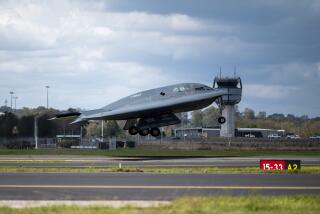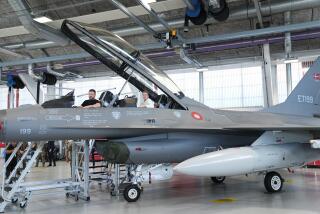Pilotless Plane Pushes Envelope for U.S. Defense
- Share via
WASHINGTON — From the moment they climbed into the first cockpits nearly a century ago, military pilots have been the daring heroes of air warfare.
But inside a St. Louis aerospace plant called the Phantom Works, engineers are assembling the prototype of an aircraft that could revolutionize air-to-ground combat--and eventually displace the pilots who conduct it.
The new Unmanned Combat Aerial Vehicle is a 26-foot-long, blunt-nosed plane that looks something like a horseshoe crab with wings. According to its advocates, it can be operated at far less cost and, in some respects, far greater efficiency than piloted planes. Another key selling point: It will reduce, and perhaps one day eliminate, the risk of American pilots being captured or injured, both of which have become increasingly unacceptable to American war planners and presidents.
In a $110-million technology program with Boeing Co., the Air Force and the Defense Advanced Research Projects Agency are developing the unmanned planes to destroy enemy air-defense batteries and command centers in the first hours of a war, one of the most dangerous times for air missions.
The “roboplanes” would take off in groups of four to launch missiles and bombs on these air defense installations, clearing the skies for piloted planes that would follow.
“This is really cutting-edge,” Air Force Secretary F. Whitten Peters, a fan of the pilotless aircraft concept, said in an interview.
The Pentagon is aiming to deploy the unmanned planes in 10 years. But some influential advocates are pushing to bring them into use quicker and in a far more ambitious role.
Congress has directed the Air Force to study whether a larger version of the new aircraft could replace the B-2 bomber, the radar-evading aircraft that was a technological marvel of the last decade. One key lawmaker, Senate Armed Services Committee Chairman John W. Warner (R-Va.), wants pilotless planes to make up one-third of the long-range aircraft fleet in 10 years.
But major technical hurdles remain. And even though the concept has influential backers, military reform advocates expect to encounter considerable resistance from fighter pilots, who have been skeptical about the capabilities of pilotless planes. The fliers want the Air Force to devote its resources to development of new tactical aircraft, in particular the F-22 fighter program.
If the pilotless planes begin to gain official favor, some experts predict, they could set off a cultural war reminiscent of the 1950s, when the emergence of intercontinental ballistic missiles drew warnings from the fighter community that pilots could become “silent silo sitters,” whose sole duty was to tend ICBMS.
In a report to the Air Force’s Air Command and Staff College, Air Force Maj. Robert C. Nolan II wrote of an intensifying clash in which reformers portray fliers as “arrogant . . . supporters of outdated technologies” and in turn are accused of being “misguided and jealous.”
The “topic is charged with emotion,” Nolan wrote.
Two unmanned prototypes are being assembled at Boeing’s Phantom Works facility in St. Louis. Work on the project also is underway at Boeing facilities in Long Beach, Seal Beach, Seattle and Mesa, Ariz.
The program has gotten a push from the success in the 1999 NATO airstrikes in Kosovo of two unmanned reconnaissance aircraft, the Predator and the Hunter, which provided desperately needed photos and data on the location of Serbian forces.
Pilotless combat planes have been around in some form nearly since the beginning of flight.
In World War I, Sperry Co. developed a track-launched plane called the Bug that was designed to put 600 pounds of explosive on target. The Nazis bombarded England with V-1 buzz bombs that looked like aircraft. Today’s cruise missile--U.S. policymakers’ current weapon of choice--is basically an unmanned attack plane that goes only one way.
The UCAVs would take a big leap forward because of recent technological advances.Designers now have far better computing and artificial intelligence capabilities and better radar, electro-optical and infrared sensors. And electronic signal compression allows a larger flow of data to and from an unmanned craft.
Advances in bombing also have increased the possibilities. Munitions such as the Joint Direct Attack Munitions, relatively cheap bombs used extensively in the Yugoslav battle, relied on satellite guidance to find their targets without the need for a pilot’s eyes. The new planes will be able to carry two of these bombs, each weighing 1,000 pounds.
According to current plans, UCAVs would be guided in their missions by a controller sitting at a computer console with two screens. The planes would embark on their mission following programmed instructions.
But if they ran into unforeseen threats or signs that their mission might endanger civilians or friendly forces, they could alert human controllers and ask for new instructions and propose solutions.
For example, an unmanned aircraft might detect an enemy fighter or a missile battery it was not expecting, either through its own infrared, radar or electro-optical sensors or through an orbiting satellite or an airborne reconnaissance plane. It would relay the information to the controller, and the plane’s computer would suggest evasive action or a counterattack.
If the unmanned craft’s sensors determined that an intended target had been moved and was now close to civilians, it could suggest that the mission be aborted or switched to a different target.
In each case, the plane’s human controller would decide what to do.
Experts say there are huge performance advantages to removing the pilot from the aircraft. Without a flier and all the equipment needed to keep him alive and in command, an aircraft can be far more compact and “stealthy.”
Piloted planes are limited in acceleration and maneuverability because too much G-force pressure on the pilot’s heart will keep it from pumping enough blood to his brain. Not so with unmanned aircraft.
In addition, it costs huge amounts of money to design aircraft for pilots, to train and retrain pilots and to maintain the aircraft for human use. It costs about $2 million for initial training of one pilot. The Air Force pays about $1 billion a year to keep the 2,000 F-16 pilots trained and ready for their job.
The new pilotless plane, by contrast, will be boxed up in movable storage containers and can remain basically untouched until put to use.
It’s expected to cost about $10 million per plane. The next-generation fighter, the F-22 Raptor--admittedly a far more capable plane--is expected to cost about $124 million per plane.
Unmanned aircraft would allow policymakers to avoid the diplomatic and political crises that can erupt when pilots are captured. In the Vietnam War, the North Vietnamese government used captured airmen as bargaining chips. In the Persian Gulf War, disputes over how to save captured U.S. F-15 pilots threatened to divide the alliance that fought Iraq.
Andrew Krepinevich, executive director of the Center for Strategic and Budgetary Assessments, a defense think tank, said that unmanned planes are thought to be naturally suited for a class of missions called the 3 Ds--”dirty, dangerous or dull.”
They would fly into grave danger to take out air defenses, conduct missions in areas where there might be lethal chemical or germ contamination or conduct mind-numbing, routine patrols, such as those that have been flown over Iraq since the 1991 war.
Experts believe that pilotless planes will do far more as the military takes its next big leap in technology, which they call the “revolution in military affairs.”
In this approaching phase, advanced computers, communication gear and sensors will work together to enable strikes at all parts of the globe without moving forces to a battle theater.
Experts believe that pilotless planes will have an ever larger role as the fighting is increasingly turned over to machines on what is called the “empty battlefield.”
In the short term, the managers of the unmanned program say they are confident that they can get the aircraft to work as billed and portray the technical problems as largely ones of integration.
Though the development schedule is challenging, “we wouldn’t be investing if we didn’t think we could get it done,” said Air Force Lt. Col. Michael Leahy, program manager for the advanced-projects agency.
He said that officials chose the air defense mission because it is “the most challenging, technically.” But if the new plane succeeds, “we believe we can do other air-to-ground missions.”
Boeing is sinking $21 million of its own money into the program, a sign that it believes the plane has promise and may lead to other unmanned aircraft efforts, said Rich Alldredge, the executive in charge of Boeing’s Phantom Works operation in St. Louis.
Yet, for unmanned fighters in general, major technical issues have not been resolved. One urgent requirement is to make sure no enemy can interfere with the programming or remote control of the planes, causing them to fall from the sky--or even turn around and attack American forces or allies.
“You know how, in the sci-fi movies, there’s a moment where the robots go wild?” asked John Pike, space and defense analyst with the Federation of American Scientists, an arms control group. “It’s a concern.”
The contract requires that the new plane adapt to shifting conditions and complete its mission if communication is lost.
Analysts say that, while good software and sensors can help solve many problems, there will always be tough situations that a pilot can handle best. “There are still good reasons to want a human in the loop,” said Air Force Secretary Peters. Despite the success of the Hunter and Predator drones, the recent history of unmanned aircraft projects has been troubled, suggesting that major obstacles may lie ahead.
DarkStar, for example, a promising high-altitude stealthy reconnaissance aircraft, was canceled a year ago after a shocking crash. Another program, called Global Hawk, has moved at a slow pace.
Pike believes that the unmanned vehicle technology is almost “maddeningly attractive” yet says he is puzzled why work on predecessor programs has moved at such a glacial pace.
One reason, analysts believe, is that unmanned craft have never had the kind of strong institutional support that has carried manned programs over bad patches.
Some Air Force officials insist that the organization is now looking more favorably on pilotless combat planes and is eager to give them a large role, if they prove capable.
But others insist that there is too much at stake in jobs and prestige.
One retired U.S. officer, who asked to remain unidentified, recalled how an Air Force acquaintance explained the issue in basic terms. No officer, the flier said, “has ever succeeded in picking up a woman in a bar by saying he commanded a wing of drones.”
(BEGIN TEXT OF INFOBOX / INFOGRAPHIC)
The Future of Air Combat?
An unmanned combat plane is being developed to possibly replace the B-2 bomber. Proponents of the Unmanned Combat Aerial Vehicle say it would operate at a lower cost and more efficiently than piloted jets.
*
UCAV SPECIFICATION
*
* Cost: $110-million program, $10 million per plane.
* Assembly: Boeing Co. facilities in St. Louis, Long Beach, Seal Beach, Seattle and Mesa, Ariz.
* Deployment: In 10 years.
* Operation: Would take off in groups of four and launch missiles and bombs on air defense installations, clearing the way for manned jets.
* Capacity: Will be able to carry two 1,000-pound bombs.
*
Source: Boeing Co.
More to Read
Sign up for Essential California
The most important California stories and recommendations in your inbox every morning.
You may occasionally receive promotional content from the Los Angeles Times.














